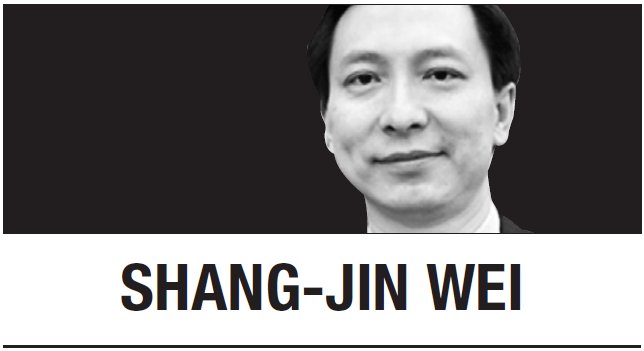 This year marks a decade since the global financial crisis erupted. For the United States, 2018 is very different from 2008. The economy has gone from the brink of collapse to the brink of overheating, thanks to a massive tax cut. The attitude toward China has also changed dramatically. Recognition that cooperation with China was necessary to manage global demand has given way to protectionism and hostility.
This year marks a decade since the global financial crisis erupted. For the United States, 2018 is very different from 2008. The economy has gone from the brink of collapse to the brink of overheating, thanks to a massive tax cut. The attitude toward China has also changed dramatically. Recognition that cooperation with China was necessary to manage global demand has given way to protectionism and hostility.Yet, for China, 2018 feels similar to 2008 in an important way: negative shocks originating in the United States pose a significant threat to its economic growth. In 2008, the shock was a decline in demand for its exports, owing to the collapse of Lehman Brothers and the ensuing global financial crisis. Today, it is the trade war initiated by US President Donald Trump’s administration.
The risks China faces are not entirely outside its control. The situation could be made worse if the country repeats the policy responses of 2008 -- namely, relying exclusively on massive fiscal and monetary stimulus to prop up demand.
While the authorities’ response a decade ago did avert a sharp recession, it also paved the way for many other problems, including soaring debt levels for local governments and state-owned enterprises, the expansion of shadow banking, the re-emergence of excess capacity in several sectors, and a decline in the relative strength of private firms. The Trump administration has invoked some of these consequences as justifications for its trade war.
In these circumstances, China might be tempted to double down on stimulating aggregate demand with short-term measures like channeling more infrastructure investment. But that approach would risk creating another decade’s worth of problems. A better strategy would be to focus on structural reforms.
Non-state-owned firms have been the most important source of growth in the last four decades, so it is encouraging that People’s Bank of China Gov. Yi Gang emphasized this principle of “competitive neutrality” in a recent speech. So far, this term has not been repeated by higher-level leadership. But the government should formally adopt it as a guiding norm for economic governance.
Similarly, when it comes to foreign trade and investment, China should adopt a principle of “government neutrality” to regulate cooperation and contractual negotiations between foreign and domestic firms. More broadly, it should continue to reduce barriers to trade and investment by foreign firms in China. Such measures would raise Chinese households’ real income by enhancing their purchasing power, while strengthening the competitiveness of the country’s corporate sector by putting pressure on less efficient domestic firms. China’s own experience following its accession to the World Trade Organization suggests that greater openness ultimately brings more prosperity to its households.
Establishing greater labor-market flexibility is the third structural reform China needs. Since the mid-1990s, the combined mandatory contribution rate for public pensions, medical care, and other benefits has officially been very high -- about 50 percent over the wage bill, which is higher than the median contribution rate in OECD countries. Yet weak enforcement meant that domestic firms largely ignored those costs. Then, in 2008, the authorities began to enforce the contribution rate vigorously, which squeezed firms. Add to that a requirement that firms must offer a long-term contract to any individual after two consecutive short-term contracts and pay a hefty severance package if they need to downsize the workforce. As a result, the economy’s ability to handle negative shocks and adjust the composition of employment has been severely diminished.
Given China’s productivity levels and stage of development, a combined mandatory contribution rate of about 35-40 percent for all government-provided benefits would be more appropriate. The adoption of that rate, together with other measures to enhance labor-market flexibility, could boost China’s economic resilience considerably.
A final reform that would go a long way toward fortifying China’s economy would be a temporary reduction of the corporate-income and value-added tax rates. I suggest a temporary tax cut for two reasons. A temporary cut would put far less pressure on the public budget than a permanent one, while simultaneously providing more incentive for firms to invest.
China’s leaders are aware of the need for most of these reforms; indeed, they have made supply-side reform their official policy mantra. But, so far, they have been focusing on reducing excess capacity and deleveraging, rather than on measures that will boost private entrepreneurs’ confidence, reduce the economy’s vulnerability to shocks, and buttress growth. Given that two of these reforms -- competitive neutrality and greater openness to both domestic private-sector firms and international firms -- would also help to assuage the US, the moment to act could not be better.
Shang-Jin Wei
Shang-Jin Wei, a former Chief Economist of the Asian Development Bank, is professor of Chinese business and economy and professor of finance and economics at Columbia University. -- Ed.
(Project Syndicate)
-
Articles by Korea Herald








![[Kim Seong-kon] Democracy and the future of South Korea](http://res.heraldm.com/phpwas/restmb_idxmake.php?idx=644&simg=/content/image/2024/04/16/20240416050802_0.jpg&u=)








![[KH Explains] Hyundai's full hybrid edge to pay off amid slow transition to pure EVs](http://res.heraldm.com/phpwas/restmb_idxmake.php?idx=652&simg=/content/image/2024/04/18/20240418050645_0.jpg&u=20240418181020)

![[Today’s K-pop] Zico drops snippet of collaboration with Jennie](http://res.heraldm.com/phpwas/restmb_idxmake.php?idx=642&simg=/content/image/2024/04/18/20240418050702_0.jpg&u=)